A New Station in Portland
NNEPRA plans to relocate the Downeaster train station in Portland, Maine to a location along the CSX Freight Mainline (parallel to St. John Street). The current station is located approximately 1 mile down a branch line. The mainline station location will reduce travel time for Downeaster riders, improve reliability of freight and passenger trains, and reduce Downeaster operating costs. These positive impacts will increase Downeaster ridership and revenue, take cars off the road and support economic development along the Downeaster Corridor. NNEPRA plans to pursue funding for final design and construction of the $55M project through the Federal Railroad Administration (FRA), in collaboration with MaineDOT.
A new station location is particularly important due to the pending addition of more Downeaster train frequencies which will provide a convenient schedule for workers commuting into and within the greater Portland region from Maine stations. Currently, the first northbound train arrives in Portland at 11:18 am, but the added train will arrive into Portland (from Wells, Saco and Old Orchard Beach) at approximately 8:00am.
The 2023 Maine State Rail Plan (MSRP) passenger rail investment program includes relocating Portland Station, forecasting that the time savings and improved accessibility to employment centers would increase Downeaster ridership by 66,000 riders annually.
The Portland Station relocation project (Project) has received strong public support, reflecting widespread interest in improved passenger rail service, creating access to jobs and regional connectivity.
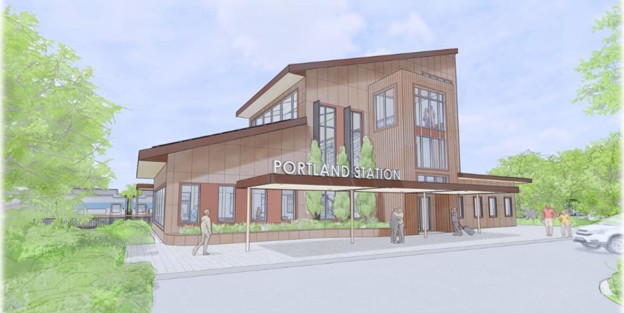
The new station is planned to be located along the CSX mainline, parallel to St. John Street. The Site selected by NNEPRA and MaineDOT, through an extensive alternatives analysis, is located between Northern Light Mercy Hospital and St. John Street.
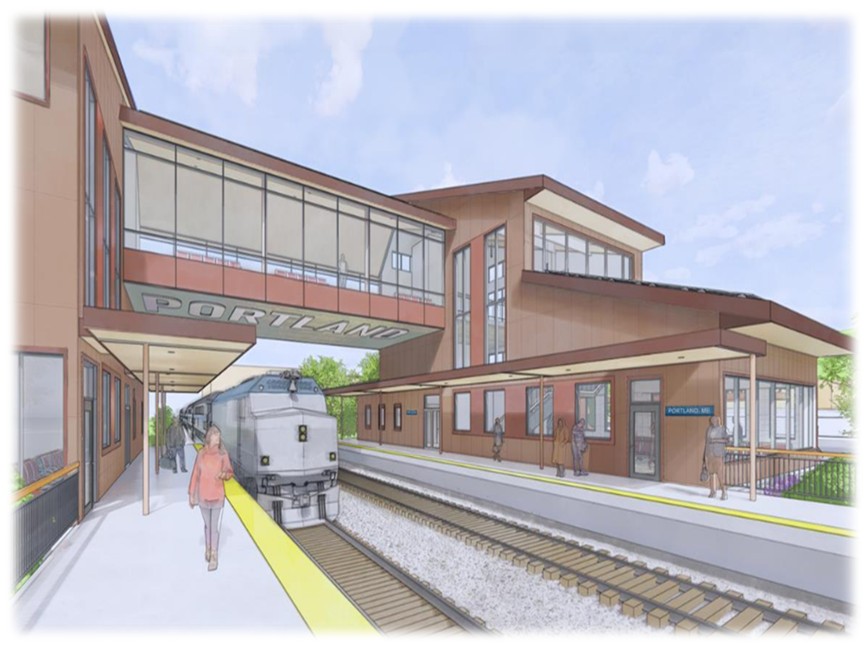
The new station will have two passenger platforms, allowing northbound and southbound trains to meet simultaneously, increasing reliability and improving schedule flexibility. The current 15-minute stop will be reduced to 2 minutes at the new location. At the new location, the current 50 minute travel time between Brunswick and Portland will be reduced to 33 minutes.
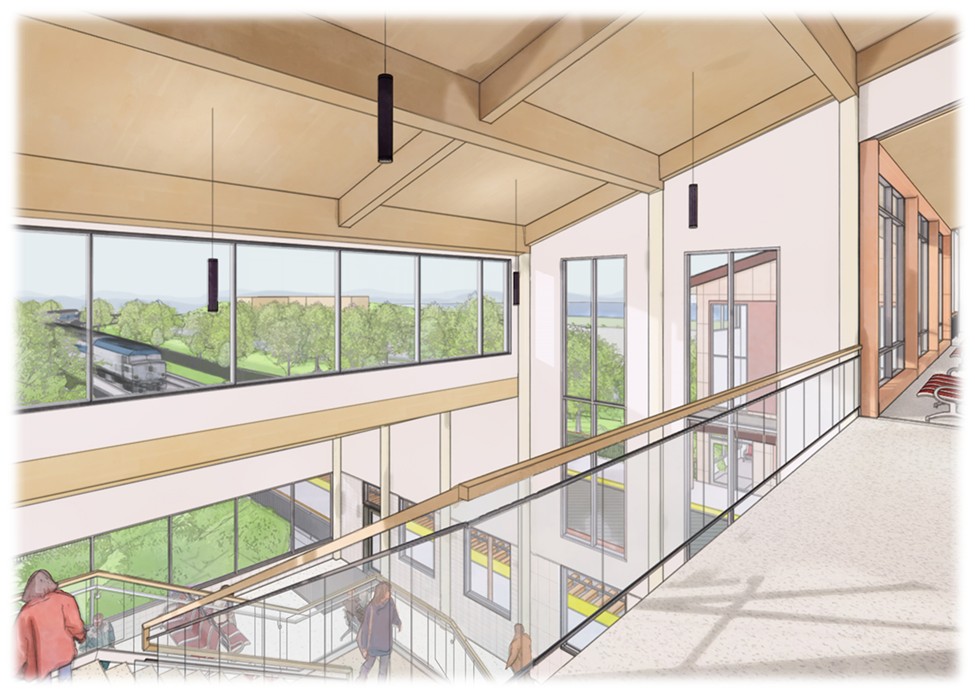
The platforms will be connected by an elevated pedestrian bridge which will provide direct access to both the Mercy Campus and Fore River Parkway, as well as the Maine Medical Center shuttle, St. John Street and the Congress Street corridor. The facility will have passenger waiting and ticketing areas and restrooms with parking planned on the St. John Street.
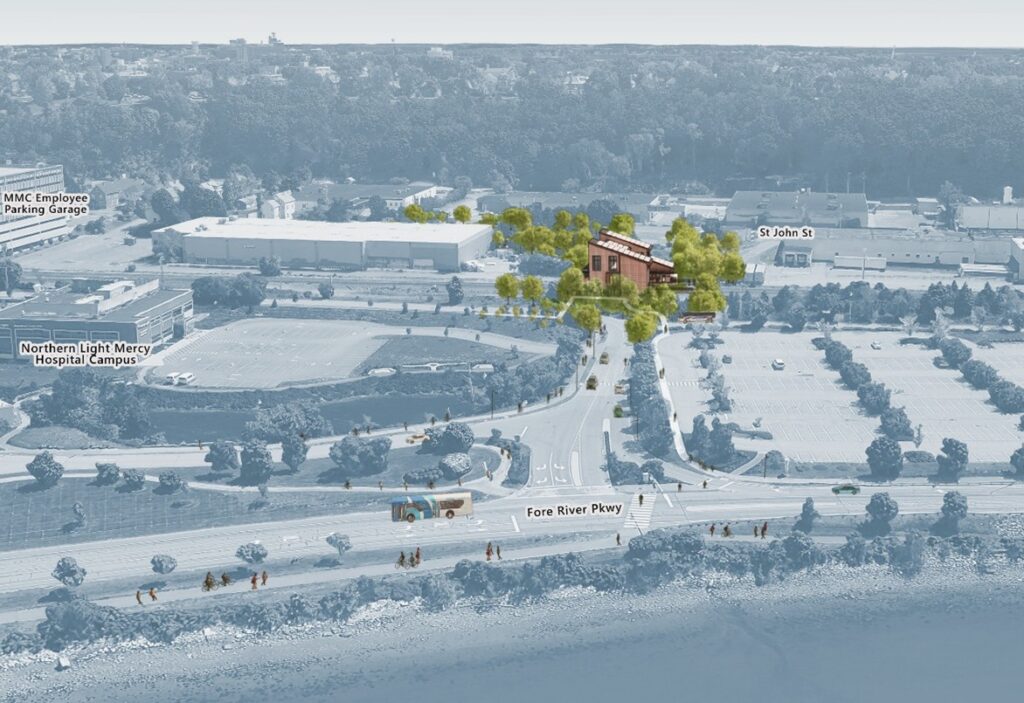
The new station location is currently served by METRO Bus Route 1 and BSOOB Bus Route 60. NNEPRA is collaborating with local transit and intercity bus providers to improve and enhance connectivity to the Downeaster when the new station is complete, including connectivity to the Portland Transportation Center and Concord Coach Lines.
A New Station is Critical to Passenger Rail Service Improvement and Growth
The current Portland Downeaster station at the Portland Transportation Center (PTC) on Thompson’s Point is located on a branch line about 1 mile from the CSX mainline. This requires trains (and passengers) travelling between stations north and south of Portland to make time-consuming reverse moves in and out of the station, adding approximately 15 minutes to each trip. This extra time makes the Downeaster less competitive than other modes of travel and hinders ridership growth while increasing labor and fuel costs. These movements also delay freight and passenger trains on the mainline, limit schedule flexibility, and prevent additional frequencies or future connecting services.
NNEPRA analyzed the cumulative impacts of the additional train moves through Fiscal Year 2024:
- Of the 598,000 passengers that rode the Downeaster in FY24, approximately 133,000 riders collectively spent more than 33,000 hours on trains backing in and out of the PTC.
- This maneuver resulted in an additional 3,650 hours of crew time and consumed 8,600 more gallons of fuel than would be required with a mainline station.
- These impacts resulted in approximately $1.1M in additional costs to passengers and the Downeaster service.
The new station will be located on the CSX mainline and will only require a 2-minute station stop, similar to other Downeaster station stops between Maine and Massachusetts, reducing trip time by approximately 13 minutes.
How was the Site Selected
In 2019, MaineDOT, in cooperation with NNEPRA, Concord Coach Lines, the City of Portland, Greater Portland Metro and GPCOG conducted a study to evaluate the benefits and challenges associated with the current station location on Thompson’s Point, and opportunities for relocation on the mainline. The Executive Summary concluded that MaineDOT would support NNEPRA in evaluating a new station on the railroad mainline between Congress Street and the Veterans Memorial Bridge Overpass.
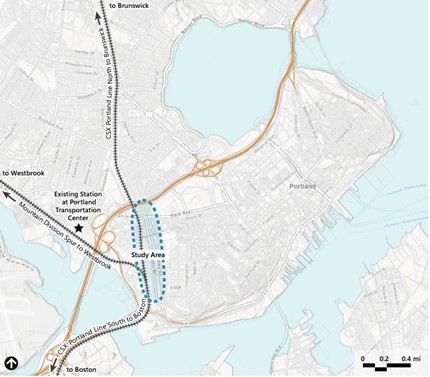
Later that year, NNEPRA contracted with VHB to initiate a detailed study process to evaluate siting options for relocating Portland Station along the Mainline, as recommended by the 2021 MaineDOT Study. The Alternatives Analysis was conducted in accordance with the project planning process outlined in the Federal Railroad Administration (FRA) Guidance on Development and Implementation of Railroad Capital Projects. The Portland Train Station Relocation Planning Report was published in December 2024.
Portland Station relocation was included in the 2023 Maine State Rail Plan (MSRP) passenger rail investment program. The MSRP forecasted that the increase in ridership due to travel time reductions through Portland and the relocation of the station to a more walkable location was projected to be 66,000 riders annually.
NNEPRA’s Alternatives Analysis considered three locations:
- Site 1: North of Congress St (McDonald’s area)
- Site 2: South of Congress St (near Union Station Plaza)
- Site 3: Adjacent to Northern Light Mercy Hospital near St. John Street
Each site was evaluated against the same criteria:
- Ability to support safe and efficient train operations
- Availability of property to support parking needs
- Vehicular, pedestrian, bike and transit connectivity
- Proximity to employment centers and demand generators
- Compatibility with land use and development initiatives
- Ability to support future rail service expansions
The Analysis included extensive public and stakeholder outreach including:
- Ongoing engagement with Amtrak, CSX, Maine Health, Northern Light Mercy Hospital (Mercy), Greater Portland Metro, Greater Portland Council of Governments (GPCOG) / Portland Area Comprehensive Transportation System (PACTS) and Portland City staff
- Presentations and discussions at NNEPRA Board Meetings and other public state/regional committee meetings
- Two virtual public meetings with extended comment periods
- Comments made at the two public meetings and in the public comment portal reflected overwhelming public support for Site 3
The Analysis concluded that:
- Site 1 is not viable due to location and track infrastructure limitations.
- Site 2 was not selected as the preferred location due to multiple site and rail operational challenges, including:
- Site 2 presents significant operational challenges for freight and passenger trains due to the close proximity to the Congress Street grade crossing.
- Property is not available for train station development:
- Site 2 abuts the Cumberland County Jail to the west. Portions of a station would be located partially on or directly abutting the County Jail. The County has submitted a letter in opposition to siting the station immediately adjacent to the jail.
- Site 2 is primarily owned by Maine Health. A train station would negatively impact the employee shuttle and would limit Maine Health’s ability to expand to accommodate the community’s increasing healthcare needs.
- Site 3 was selected as the location which best meets project needs for numerous reasons:
- Site 3 is supported by Amtrak, CSX, MaineDOT, and the majority of the public who provided site selection comments during and following the first public meeting.
- Site 3 creates no new impacts to grade crossings and requires the least amount of costly infrastructure improvements.
- Site 3 is the only site that provides direct access to the Mountain Division branch, which preserves the opportunity for future passenger rail development to the west.
- Site 3 is the only site with direct access to maintenance facilities on the Mountain Division and best supports train operations.
- Site 3 offers direct access to more jobs than Site 2 and the current station.
- Site 3 is the only site which can provide varying levels of multimodal access from the platforms on both sides of the tracks, connecting two areas of the city currently bifurcated by the railroad.
- Site 3 best improves pedestrian/bike connectivity by connecting St. John Street to the Fore River Parkway, and being located between the major throughways of West Commercial Street and Congress Street.
- Site 3 provides connectivity to the Fore River Parkway and the opportunity for future collaboration with Mercy Hospital.
- Site 3 is comprised of land where acquisition is possible.
- Site 3 provides the most direct access to the Concord Coach Lines intercity bus station via the Fore River Parkway.
- Site 3 complies with local zoning code and land use, and supports Transit Oriented Development (TOD) opportunities within 0.5 miles of the station site.
In June 2024, the NNEPRA Board of Directors voted to support Site 3 based on the technical findings of VHB; input from key stakeholders such as CSX, MaineDOT, and Amtrak; public feedback from a public meeting; and written comments received through the public portal.
In addition to best supporting safe railroad operations, Site 3 will connect St. John Street and the Fore River Parkway via a pedestrian bridge over the railroad and provide direct access to the Northern Light Mercy Hospital campus, Maine Medical Center shuttle, and several bus connections (i.e., GP Metro, BSOOB) and enhance bike and pedestrian connectivity.
Following the Board vote, NNEPRA held a second public meeting to determine whether the public supported the Board decision. The majority of comments specific to site selection that were received at the second meeting supported the Board’s selection of Site 3.
A Portland Train Station Relocation Planning Report dated December 5, 2024, was prepared and submitted to NNEPRA (Final Report) summarizing the Alternatives Analysis process, findings, and recommendations. The Final Report included a description of analysis conducted prior to the vote of the NNEPRA Board, noted the Board’s action in August 2024, and included subsequent information received after the Board vote. The additional information received after the Board vote confirmed the earlier findings in support of Site 3 and the Board declined to take any action to modify its earlier support for Site 3.
Project Timeline
| Date | Goal | December 2024 | Portland Train Station Relocation Planning Report Published | August 13, 2024 thru August 27, 2024 | Formal Public Comment Period | August 13, 2024 | Virtual Public Meeting | April 25, 2024 thru May 10, 2024 | Formal Public Comment Period | April 25, 2024 | Virtual Public Meeting | Winter 2024 | Project planning with Maine DOT, public, and stakeholder involvement |
|---|---|
| Winter 2021 | Maine DOT PTC Draft Study Complete |
Resources
| Project Support | Download PDF | |
| Portland Train Station Relocation Planning Report, December 2024 | Download PDF | |
| Public Meeting, August 2024 | Video Recording | Download PDF of Slides |
| Public Meeting, April 2024 | Video Recording | Download PDF of Slides |
| Maine State Rail Plan, 2023 | Download PDF |
